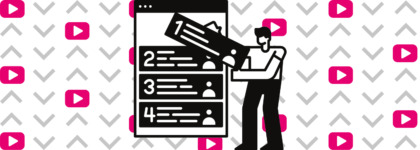How (and Why) To Caption Youtube Videos You Don’t Own
Updated: August 10, 2022
[How-To Guide] Adding Subtitles + CC to YouTube Videos
This multi-part blog series will highlight three valuable accessibility features for YouTube captions and subtitles. In our second blog of the series, we’ll discuss how to add captions/subtitles to YouTube videos you don’t own.
Every day, more than 500 million hours of video content is watched on YouTube. While many of these videos are watched for pure entertainment, there’s also a large audience using YouTube content in educational settings. Incorporating YouTube videos as supplemental material in school course content has become quite common, but it has also posed an accessibility challenge in terms of Section 508 closed captioning compliance – educators are often left wondering if they need to (or how they can) get subtitles on YouTube videos without CC that they do not own.
Look no further! In this post, we’ll go over important considerations and a quick life hack for adding subtitles to YouTube clips that you don’t own.
Read the how-to guide: adding captions to YouTube 📓
Do you need to caption YouTube videos?
For education
In addition to accessibility, there are numerous reasons to add captions to educational videos. To better understand how/why students are using captions, we conducted a national research study with Oregon State University that proved captions are beneficial to students in learning environments. The results? 98.6% of students find captions helpful – almost ALL of them! In fact, 75% of students reported using captions as a learning aid. Considering the number one reason students use captions was to help them focus on video content, the provision of closed captions is proven to benefit more than just students who may be d/Deaf or hard of hearing.
On top of that, the inclusion of closed captions allows students a greater degree of flexibility to watch videos in sound-sensitive environments. For example, watching video in the library while studying to aid in comprehension, to help with spelling/understanding complex terminology, or improve comprehension of professors with heavy accents. In some cases, you may also be legally required to provide captions.
For compliance
If an educational institution accepts federal funding, they are bound by Section 504 of the Rehabilitation Act of 1973 to make all resources and communication universally accessible to people with disabilities. For d/Deaf or hard of hearing people, this means adding closed captions to video content. Many state colleges accept federal funding and thus must caption any video used inside or outside of the classroom as part of coursework.
Even if an educational institution does not accept federal funding, some states requires observance of Section 508 compliance to make video accessible with closed captioning. Additionally, state schools are subject to accessibility requirements of Title II of the ADA. The Americans with Disabilities Act (ADA) categorizes all educational institutions as “places of public accommodation,” which means it is against federal law to discriminate against people with disabilities. This creates the requirement that all schools should caption videos used for educational purposes, and these requirements extend even to online-only classes.
Can you (legally) caption YouTube videos you don’t own?
When it comes to getting subtitles on YouTube videos without CC available, a lot of people wonder whether there is a conflict between copyright law and accessibility law. Typically, providing accessible educational content is considered fair use under copyright law. However, you still want to avoid illegally copying, publishing, or distributing the video – fortunately, we’ve got simple solutions to transcribe and/or caption videos without republishing them.
How Do You (Legally) Caption Videos You Don’t Own?
The life hack
If you’re a Google Chrome user, the browser offers a quick fix to generate live captions on any streaming video or audio file. The feature, launched in early 2021, uses machine learning to provide real-time captions for any audio source in English.
Here’s how to activate live captions for your Google Chrome browser:
- Click the vertical ellipsis in the top right of your Chrome menu bar, and select ‘Settings’
- Click ‘Advanced,’ then select ‘Accessibility’
- ‘Live Caption’ should be the first option available to toggle
The long-term
Ultimately, the best solution for captioning a web video you don’t own is by using professional captioning service, like 3Play Media. 3Play offers free tools that allow publishers to create fully interactive and accessible video experiences for viewers. Our platform and accessible video player gives users the ability to add captions, interactive transcripts, audio description, and even SEO to videos they don’t own – including videos on YouTube.
When you use a professional captioning service, it means the video’s original creator and publisher still benefit from the views of their video on your website. There’s no need to republish the video onto your YouTube channel, and you can still get the closed captioning you need – 100% legally!
Want to learn more? Download the guide.

This blog was originally published by Emily Griffin on September 16, 2015 as How to Caption Someone Else’s YouTube Video, and has since been updated for comprehensiveness, clarity, and accuracy.
This blog post is written for educational and generally informative purposes only, and does not constitute specific legal advice. This blog should not be used as a substitute for competent legal advice from a licensed professional attorney in your state.







